Chevrolet S-10
| Chevrolet S-10 GMC S-15/Sonoma | |
|---|---|
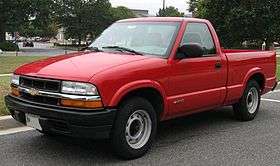 | |
| Overview | |
| Manufacturer | Chevrolet/GMC (General Motors) |
| Production |
1982–2005 (North America) 1995–Present (Brazil) |
| Body and chassis | |
| Class | Compact pickup truck |
| Layout | Front engine, rear-wheel drive / four-wheel drive |
| Chronology | |
| Predecessor | Chevrolet LUV |
| Successor | Chevrolet Colorado / GMC Canyon (North America only) |
The Chevrolet S-10 is a compact pickup truck that is produced by Chevrolet. It was the first compact pickup of the big three American automakers. When it was first introduced in 1982, the GMC version was known as the S-15 and later renamed the GMC Sonoma. A high-performance version was released in 1991 and given the name of GMC Syclone. The pickup was also sold by Isuzu as the Hombre from 1996 through 2000, but only in North America. There was also an SUV version, the Chevrolet S-10 Blazer/GMC S-15 Jimmy. An electric version was leased as a fleet vehicle in 1997 and 1998. Together, these pickups are often referred to as the S-series.
In North America, the S-series was replaced by the Chevrolet Colorado, GMC Canyon, and Isuzu i-Series in 2004.
The S-Series ended production in Brazil in 2012, being replaced by the Chevrolet Colorado, but still with the name S-10.
First generation (1982–1993)
| First generation | |
|---|---|
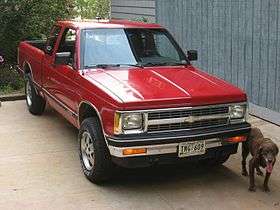 | |
| Overview | |
| Also called |
|
| Production | 1982–1993 |
| Assembly |
United States: Moraine, Ohio (Moraine Assembly) Shreveport, Louisiana (Shreveport Assembly) Pontiac, Michigan |
| Body and chassis | |
| Platform | GMT325 |
| Related | |
| Powertrain | |
| Engine | |
| Transmission |
|
| Dimensions | |
| Wheelbase |
|

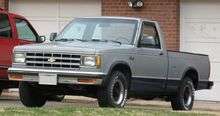
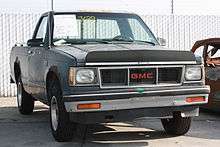
The first compact truck from the big three automakers was the rebadged Isuzu KB sold since 1972 as the Chevrolet LUV. The 1973 Arab oil embargo forced GM to consider designing a domestically produced compact pickup truck. As usual, parts from other GM chassis lines (primarily from the GM G-body intermediates) were incorporated. The first S-series pickups were introduced in 1982. The base engine (manufactured in Japan and imported) was a 1.9L Isuzu 4 cylinder (RPO LR1) shared with the LUV and Isuzu P'UP) with the GM 2.8L on the option list. The Chevrolet and GMC models were identical apart from the grille, tailgate and assorted insignia. An extended cab and "Insta-Trac" four-wheel drive were added the next year along with two new engines - a 2.0L (RPO LQ2) sourced from the J-platform automobiles along with an Isuzu 2.2L (RPO LQ7) diesel).
Track width was similar to the former GM H-body subcompacts (Vega/Monza).
The sport utility S-10 Blazer and S-15 Jimmy debuted in 1983; GM was the second to introduce compact sport utilities, behind Jeep but ahead of Ford. This occurred again where 4-door variants were introduced in March 1990 as 1991 models alongside the badge-engineered Oldsmobile Bravada.
New heavy-duty and off-road suspensions appeared in 1984 along with a hydraulic clutch, while the big news for 1985 was the discontinuing of the Cavalier's 2.0 L OHV I4 in favor of Pontiac's 2.5 L "Iron Duke" OHV I4. The OHV-derived 2.2 L diesel engine and 1.9 L SOHC gas engine, both from Isuzu, were gone the next year, leaving just the Iron Duke and updated 2.8 L V6. A much-welcomed 4.3 L V6 was added for 1988, and anti-lock brakes came the next year.
The GMC S-15 became the GMC Sonoma in 1991, and the Sierra trim packages were dropped to avoid confusion with the new GMC Sierra full-size pickup. The GMC Syclone also appeared that year. The Sonoma GT bowed in 1992. Added to this was the 4.3 L V6 Vortec W code engine. This generation's last year was 1993.
The Vortec has a balance shaft, roller lifters, different heads, and Central Port Injection. The 1992 and 1993 engine came in either a 195 hp (145 kW) or 205 hp (153 kW) rating. The High Performance version came with a larger diameter Y pipe, and was only installed in some of the S-10 Blazers and S-15 Jimmies as well as the S-10 Pickups
The S-10 Baja is an optional appearance package that was put on any type 4wd S-10 (regular-cab w/ short-box, regular-cab w/ long box and extended-cab w/ short box) from 1989 to 1991. The trucks came in 3 colors: Midnight Black, Apple Red and Frost White. The Baja option included: a roll bar with off-road lights, a front tubular grille guard with fog lights, a tubular rear bumper, an under-body shield package (transfer case shield, front differential shield, fuel tank shield, oil pan/steering linkage shields), a suspension package, a Chevrolet windshield banner, Baja decals on the box sides and one inch wide body striping. Extra cost Baja options included: a cargo-net end-gate, aluminum outlaw wheels and a special box-mounted spare tire carrier w/ aluminum wheel. In 1991 the S10 Baja's came with special BAJA embroidered red and grey bucket seats and unique red door panel trim.
The S-10 Cameo, and Cameo EL, appearance package for the S-10 pickup 2WD, from 1989-1991, In 1989 these trucks came in 3 color choices Apple Red, Frost White or Midnight black solid exterior colors, In 1991 other Tone-on-Tone paint schemes were available, and has the additional exterior features: a wraparound front bumper fascia with fog lamps. lower body ground-effects moldings and wheel flares, a flush-fitting tailgate valance, rear roll pan (If state laws allowed), and "Cameo" lettering on the doors and tailgate.
Other appearance packages include the S-10 Back Country, predecessor to the Baja. The S-10 Top Gun edition, And The GMC Sonoma SST.
Sonoma GT
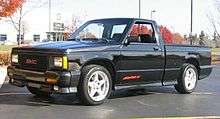
The Sonoma GT was a performance package available on the 2WD regular cab short bed Sonoma. It was available for the 1992 model year only as an entry-level version of the GMC Syclone. A total of 806 were built. The truck was powered by an enhanced Vortec 4.3 L V6. It featured central multi-port fuel injection and produced 195 hp (145 kW) and 260 lb·ft (350 N·m) of torque.[1] It was equipped with a 4L60 automatic transmission and a limited-slip differential with 3.42:1 gearing.
Modified by Production Automotive Services of Troy, Michigan, it was fitted with the Syclone interior package featuring black cloth bucket seats with red piping, a special gauge package, and a floor shift console.
Sonoma GT color breakdown;
- 1991 Black w/ Black (1 Total)
- Black w/ Black (408 Total)
- Black w/ Gray (41 Total)
- Frost White w/ Gray (101 Total)
- Apple Red w/ Gray (180 Total)
- Bright Teal w/ Gray (48 Total)
- Forest Green Metallic w/ Gray (14 Total)
- Aspen Blue w/ Gray (14 Total)
1993 Sonoma
Some 1992 and 1993 Sonomas came with a factory equipped L35 W code engine. For 1993 no specialty labeling or limited edition tags were known to be used with the W code engine. Production totals for these vehicles are unknown.
1991 Syclone
This GMC came with an LB4 4.3L V6 with lower compression pistons and a turbocharger. They produced ~280 hp.
Engines
| Years | Engine | Power | Torque |
|---|---|---|---|
| 1982–1985 | 1.9 L LR1 Isuzu I4, 2-barrel | 82 hp (61 kW) @ 4600 RPM | 101 lb·ft (137 N·m) @ 3000 RPM |
| 1983–1984 | 2.0 L LQ2 GM 122 I4, 2-barrel | 83 hp (62 kW) @ 4600 RPM | 108 lb·ft (146 N·m) @ 2400 RPM |
| 1984–1985 | 2.2 L LQ7 Isuzu Diesel I4 | 62 hp (46 kW) @ 4300 RPM | 96 lb·ft (130 N·m) @ 2200 RPM |
| 1985–1986 | 2.5 L LN8 Iron Duke TBI I4, | 92 hp (69 kW) @ 4400 RPM | 134 lb·ft (182 N·m) @ 2800 RPM |
| 1987-1989 | 92 hp (69 kW) @ 4400 RPM | 130 lb·ft (176 N·m) @ 3200 RPM | |
| 1990 | 94 hp (70 kW) @ 4400 RPM | 130 lb·ft (176 N·m) @ 3200 RPM | |
| 1991-1993 | 2.5 L L38 Iron Duke TBI I4, | 105 hp (78 kW) @ 4800 RPM | 135 lb·ft (183 N·m) @ 3200 RPM |
| 1982 | 2.8 L LR2 60° V-6, 2-barrel | 110 hp (82 kW) @ 4800 RPM | 148 lb·ft (201 N·m) @ 2000 RPM |
| 1983-1984 | 110 hp (82 kW) @ 4800 RPM | 145 lb·ft (197 N·m) @ 2100 RPM | |
| 1985 | 115 hp (86 kW) @ 4800 RPM | 150 lb·ft (203 N·m) @ 2100 RPM | |
| 1986 | 2.8 L LL2 60° V-6, TBI | 125 hp (93 kW) @ 4800 RPM | 150 lb·ft (203 N·m) @ 2200 RPM |
| 1987-1993 | 125 hp (93 kW) @ 4800 RPM | 150 lb·ft (203 N·m) @ 2400 RPM | |
| 1988–1992 | 4.3 L LB4 90° V-6, TBI | 160 hp (119 kW) @ 4000 RPM | 230 lb·ft (312 N·m) @ 2800 RPM |
| 1993 | 165 hp (123 kW) @ 4000 RPM | 235 lb·ft (319 N·m) @ 2400 RPM | |
| 1992-1993 | 4.3 L L35 90° V-6, CPI | 195 hp (145 kW) @ 4500 RPM | 260 lb·ft (353 N·m) @ 3600 RPM |
Second generation (1994–2004)
| Second generation | |
|---|---|
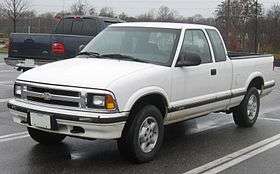 | |
| Overview | |
| Also called |
GMC Sonoma Isuzu Hombre Opel Sierra |
| Production |
1994–2004 (North America) 1995–2012 (Brazil) 1996–2000 (Isuzu Hombre) |
| Assembly |
Shreveport, Louisiana, United States Linden, New Jersey, United States Ingersoll, Ontario, Canada (CAMI Automotive) Ottawa, Ontario, Canada São José dos Campos, Brazil (GM Brazil) |
| Body and chassis | |
| Platform | GMT325 |
| Related | |
| Powertrain | |
| Engine |
2.2 L I4 4.3 L V6 |
| Transmission |
4-speed 4L60-E automatic 5-speed Borg-Warner T-5 manual (1994–95 I4) 5-speed NV1500 manual (1996+ I4) 5-speed NV3500 manual (V6) |
| Dimensions | |
| Wheelbase |
108.3 in (2,751 mm) (reg. cab short bed) 117.9 in (2,995 mm) (reg. cab long bed) 122.9 in (3,122 mm) (ext. cab short bed) |
| Length |
190 in (4,826 mm) (short bed) 203 in (5,156 mm) (ext. cab) 205 in (5,207 mm) (long bed) |
| Width | 67.9 in (1,725 mm) |
| Height | 63.5 in (1,613 mm) |

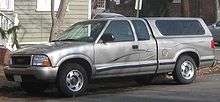

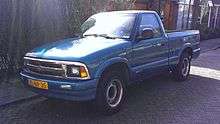
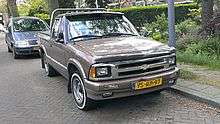
The second-generation trucks arrived in the 1994 model year. All of the special models (the Syclone, Typhoon, and Sonoma GT) were discontinued, but the changes to the pickup brought it in line with its major competitor the Ford Ranger. The Iron Duke 4-cylinder and 2.8 L 60° V6 engines were retired, the 4.3 L Vortec V6 was enhanced, and a new 2.2 L 4-cylinder engine (which had been introduced in 1990 on various FWD GM compact and mid-size platforms) became the engines of choice to power the second generation of S-10's. In compliance with the Clean Air Act, all 2nd Generation S-10s and Sonomas equipped with air-conditioning used CFC-free R134a refrigerant beginning in the 1994 model year. The all new 1994 S-10 didn't offer any airbag, presumably as a temporary measure to economize the introduction of the new body styles, as well as to gradually phase out steering wheel designs that didn't accommodate for airbags, though the vehicle itself was slated for airbag capability.
Many of the chassis components were the same as the first generation (the A-frames between the first and second generation were the same although they were originally sourced from GM's G-body vehicle lineup), along with the steering knuckle, leaf springs, and differential assembly but suspension and axles were greatly enhanced. Lower A-frames for the 2WD had 1/4 inch thicker steering stops - the second generation A-frames are commonly used as an upgrade for the first generation. Utility models (Blazer, Jimmy, Bravada) came with thicker front and rear sway bars.
Generally, for the 2WD trucks, the 8.5-inch rear end was only used when it came with both a manual transmission and the large 4.3 L (262 cu in) V6 engine; it was an option for 4WD trucks with either transmission. This was also the year that GM introduced the ZR2 Offroad Package.
For 1995, a driver's-side air bag was added as well as day time running lights. In 1996 the 4.3 L engine was refreshed, and a third (rear) door was added for extended cab models, along with the sportside bed option. In 1998, the exterior, interior, brakes, and 2.2 L I4 engine were refreshed, along with a "next-generation" supplemental restraint system that added a passenger-side air bag. "Auto-Trac" all-wheel drive also became an option starting in 1999 for the 4WD Blazers. The SS package was replaced by the "Xtreme" package. In 2001 a crew cab option was added and was available in 4WD and automatic transmission only. For the 2005 model year, the regular and extended cab models were discontinued; only the crew cab model was retained.
Base 2WD models came with 15x6.5-inch wheels with directional vents, Xtreme and ZQ8 models came with 16x8-inch wheels while 4WD models (including the ZR2) used 15x7-inch wheels. The 14-inch (360 mm) wheels used on the first generation were discontinued.
SS
The Chevrolet S-10 SS was a high-performance version of the S-10, introduced in 1994. Fewer than 3000 SS's were produced yearly on average. When introduced, the SS was sold in only three colors: Onyx Black, Summit White, and Apple Red. The SS was discontinued in 1998. In 1999, it was replaced by the S-10 Xtreme.
A 4.3-liter V6 (which was optional on regular S-10s) was the standard engine used in the SS version, producing between 180 and 200 hp (149 kW). The SS included lowered suspension (1996–98), cosmetic changes such as a different grille, body-colored bumpers, 16-inch wheels (1996–98, similar in design to the 1991/92 Camaro Z28 with bowtie center caps), and other sporty touches. All SS versions were regular cabs. A step-side version was available from 1996 to 1998. The SS option package was only available with an automatic transmission and 3.42 posi-traction rear-end.
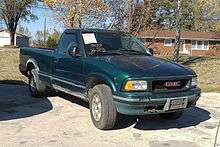
ZR2
The ZR2 package was an off-road package available for the second generation Chevy S-10. The ZR2 package included a 4-inch (100 mm) wider track width, a boxed ladder-type frame with modified suspension mounting points, larger wheel and axle bearings, 31-inch all-terrain tires, a suspension lift (approximately 3 inches more ground clearance vs. a regular 4wd S-10), upgraded Bilstein suspension, fender flares, alloy wheels, and an 8.5-inch Chevy 10-bolt rear differential with 3.73:1 gears and Eaton MLocker (Coded as G80)
Isuzu Hombre
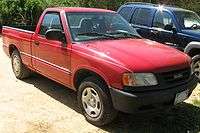
In 1996, Isuzu replaced its Pick Up with a version of the Louisiana-built Chevrolet S-10, the Isuzu Hombre, based on the Brazilian market S-10 (the front grille and fenders are based on the Brazilian S-10 along with the truck bed sheet metal). The Hombre differs from its GM siblings mostly in the front sheetmetal, with different lights, grille, front bumper and front fenders, which are more flared out. The rear quarter panels are also different, as they have a slight flare over the wheel well to match the front fenders. - which was shared with the Brazilian-built Chevrolet S10 pickup. The Hombre had a much smaller range of equipment options. The Spacecab extended cab, V6 and four-wheel drive was added from 1997 to 1998.
Two trim levels were offered: the base S and the uplevel XS. The XS had features like a cassette tape deck, higher-grade interior fabric, a tachometer, a sliding rear window, and a split 60/40 seatback. Hombres were equipped with the Chevrolet S-series 15 x 7 steel wheels (with 8 directional vents) - the Hombre wheels were painted black (the S10, Sonoma, and Blazer/Jimmy wheels were painted silver) since a majority were equipped with wheel covers with the Isuzu logo. Hombres were also available with the S-10's aluminium wheels with Isuzu center caps.
Slow sales resulted in production ending in 2000. It would be another six years before Isuzu re-entered the pick-up market with another rebadged Chevrolet, the i-Series.
Engines
| Years | Engine | Power | Torque | VIN letter |
|---|---|---|---|---|
| 1994–2000, 2003 | 2.2 L Vortec 2200 (LN2) I4 | 110-120 hp @ 5200 RPM | 130–140 lb·ft (176–190 N·m) @ 2800 RPM | 4 |
| 2000-2002 | 2.2 L Vortec 2200 (L43) I4 | 120 hp (89 kW) @ 5000 RPM | 140 lb·ft (190 N·m) @ 3600 RPM | 5 |
| 1994 | 4.3 L 90° (LB4) V-6, TBI | 165 hp (123 kW) @ 4000 RPM | 235 lb·ft (319 N·m) @ 2400 RPM | Z |
| 1995 | 155 hp (116 kW) @ 4000 RPM | |||
| 1994 | 4.3 L Vortec 4300 (L35) V-6, SCPI | 200 hp (150 kW) @ 4500 rpm | 260 lb·ft (350 N·m) @ 3600 rpm | W |
| 1995 | 190 hp (140 kW) @ 4500 rpm | 260 lb·ft (350 N·m) @ 3400 rpm | ||
| 1996-2002 w/ 2WD | 180 hp (134 kW) @ 4400 RPM | 245 lb·ft (332 N·m) @ 2800 RPM | ||
| 1996-2002 w/ 4WD | 190 hp (142 kW) @ 4400 RPM | 250 lb·ft (339 N·m) @ 2800 RPM | ||
| 1996-1999 w/ 2WD | 4.3 L Vortec 4300 (LF6) V-6, MPFI | 175 hp (130 kW) @ 4400 RPM | 240 lb·ft (325 N·m) @ 2800 RPM | X[4] |
| 1996-1999 w/ 4WD | 180 hp (134 kW) @ 4400 RPM | |||
| 2003 w/ 2WD | 4.3 L Vortec 4300 (LU3) V-6, MPFI | 180 hp (134 kW) @ 4400 RPM | 245 lb·ft (332 N·m) @ 2800 RPM | X |
| 2003-2004 w/ 4WD | 190–200 hp (142–149 kW) @ 5400 RPM | 260 lb·ft (353 N·m) @ 2800 RPM |
Third generation (2012–present)
| Third generation | |
|---|---|
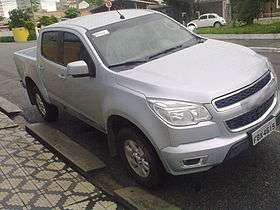 | |
| Overview | |
| Also called |
GMC Canyon Isuzu I Series Chevrolet Colorado (North America) |
| Production | 2012–present |
| Body and chassis | |
| Related | |
Although the North American version of the S-series was discontinued in 2004, the second generation S-10 was still being built in Brazil until 2012, when it was replaced by a Brazilian built version of the Chevrolet Colorado called the S-10. The third generation S-10 offers a 2.4 L Flexpower flex-fuel engine or a 2.8 L Duramax diesel engine.
In 2016, GM Brazil announced that it will discontinue Brazilian production of the S10/Colorado and all other Brazilian production in 2018. (Source?)
References
- ↑ Schroeder, Don (December 1992). "GMC Sonoma GT". Car and Driver.
- ↑ Chevrolet S-10 Product Brochures. 1982–1993.
- ↑ Chevrolet S-10 Product Brochures. 1994–2004.
- ↑ https://service.gm.com/dealerworld/vincards/
External links
![]() Media related to Chevrolet S-10 at Wikimedia Commons
Media related to Chevrolet S-10 at Wikimedia Commons
| GMC, a marque of General Motors, light truck timeline, international market, 1980s–present | ||||||||||||||||||||||||||||||||||||||
|---|---|---|---|---|---|---|---|---|---|---|---|---|---|---|---|---|---|---|---|---|---|---|---|---|---|---|---|---|---|---|---|---|---|---|---|---|---|---|
| Type | 1980s | 1990s | 2000s | 2010s | ||||||||||||||||||||||||||||||||||
| 0 | 1 | 2 | 3 | 4 | 5 | 6 | 7 | 8 | 9 | 0 | 1 | 2 | 3 | 4 | 5 | 6 | 7 | 8 | 9 | 0 | 1 | 2 | 3 | 4 | 5 | 6 | 7 | 8 | 9 | 0 | 1 | 2 | 3 | 4 | 5 | 6 | 7 | |
| Subcompact car | Chevette | |||||||||||||||||||||||||||||||||||||
| Compact crossover | Terrain | |||||||||||||||||||||||||||||||||||||
| Mid-size crossover | Terrain | |||||||||||||||||||||||||||||||||||||
| Acadia | ||||||||||||||||||||||||||||||||||||||
| Full-size crossover | Acadia | |||||||||||||||||||||||||||||||||||||
| Compact SUV | Tracker | |||||||||||||||||||||||||||||||||||||
| Mid-size SUV | S-15 Jimmy | Jimmy | Envoy | |||||||||||||||||||||||||||||||||||
| Typhoon | ||||||||||||||||||||||||||||||||||||||
| Full-size SUV | K5 Jimmy | Yukon | Yukon | Yukon | Yukon | |||||||||||||||||||||||||||||||||
| Suburban | Suburban | Yukon XL | Yukon XL | Yukon XL | ||||||||||||||||||||||||||||||||||
| Coupé utility | Caballero | 500 | ||||||||||||||||||||||||||||||||||||
| Compact pickup | S-15 Sonoma | Sonoma | ||||||||||||||||||||||||||||||||||||
| Syclone | ||||||||||||||||||||||||||||||||||||||
| Mid-size pickup | Canyon | Canyon | ||||||||||||||||||||||||||||||||||||
| Full-size pickup | C/K | Sierra | Sierra | Sierra | Sierra | |||||||||||||||||||||||||||||||||
| Van | Safari | Safari | ||||||||||||||||||||||||||||||||||||
| G-Series | Savana | Savana | ||||||||||||||||||||||||||||||||||||
| Vehicles are available only in Argentina | ||||||||||||||||||||||||||||||||||||||
| Vehicles are available only in the Middle East | ||||||||||||||||||||||||||||||||||||||
| Vehicles are available only in Canada | ||||||||||||||||||||||||||||||||||||||